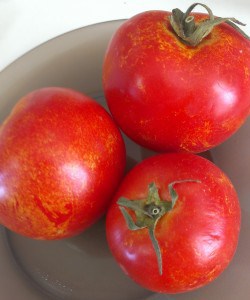 I use a pressure cooker to make a large batch of tomato sauce. Then I freeze it in batches to use in lasagna, on top of pasta or grains, to spice up leftovers, or as a base for meat, fish or vegetables.
I use a pressure cooker to make a large batch of tomato sauce. Then I freeze it in batches to use in lasagna, on top of pasta or grains, to spice up leftovers, or as a base for meat, fish or vegetables.
This post contains instructions for cooking in a conventional pot or crockpot.
The freshest, most colorful vegetables and herbs will make the best sauce, but you can use a few older vegetables too. Don’t worry too much about vegetable proportions. Just use what you have.
Ingredients to make about five liters of sauce:
- two tablespoons oil
- 4 onions, peeled and chopped
- 2-3 peppers, chopped
- 1-2 zucchini, chopped
- 2-4 stalks of celery, including leaves, chopped
- 3-4 large cans of chopped tomatoes, or the equivalent fresh. You can chop these in the processor, or cook them whole if you are planning to use an immersion blender.
- A few cloves of garlic, chopped.
- Bay leaves, oregano, parsley, dill, coriander, or other herbs.
- 1-2 cans of unadulterated tomato paste (some brands contain sugar). I can get 28x concentration, which adds a rich flavor.
Fennel, mushrooms, and hot peppers can also be added. For more about pressure cookers, see my post here.
Instructions:
- Heat the oil in the pressure cooker (or pot) and add the onions. Stir occasionally until the onions are translucent, about 5-10 minutes.
- Add the remaining ingredients. To preserve the full flavor of herbs, leave them out until the end. Or feel free to be lazy.
- Seal the pressure cooker.
- When it begins to steam and hiss, lower the heat (you may want to move it to a smaller burner).
- Cook for fifteen minutes.
- Release the steam naturally without opening the lever. If you decided to add the herbs at the end you can use the lever to release the steam after 15 minutes, cool the cooker enough to open it, add the herbs, and cook without pressure for a few minutes. Or cook with steam for another two minutes.
- Turn off the heat and allow the pressure cooker to cool off.
- In a regular pot, cook for forty-five minutes, adding the herbs for the last ten minutes.
- If you’re using acrockpot, there’s no need to saute onions. Cook for five hours on low.
- Blend sauce with an immersion blender, if desired. [Thanks to TDR for the reminder to remove the bay leaf first.]
- Ladle sauce into shallow freezer containers, leaving a half-inch at the top for expansion. Keep some in the refrigerator to use in the next few days and freeze the rest.
If you enjoyed this post you might also like:

I am not sure posting about such an enticing sauce is allowed on a fast day. 🙂
Thanks for answering my Q about homemade sauce. Your recipe sounds easy and delicious- and so much cheaper and healthier than the stuff they sell in jars. I’ll bet some basil would be good in that, too.
Yum. I second what Ilana-Davita says, although I actually find I end up reading cookbooks on fast days.
And the jar stuff always has added sugar – I bet if the tomatoes were fresh enough, they would add their own natural sweetness.
Shalom Hannah.
Thank you for a site that endeavors to simplify the cooking experience. Getting tired of the pretentious.
Reading your recipes takes me back to childhood memories of my Bobba, and her wonderful cooking on a coal fired stove, and of my Zeider taking a chicken to the Scheichet on a friday.
Please could you indicate the can sizes (mass) for this recipe? If you only have the values in ‘quarts’ or ‘ounces’ I can convert, no problem at all.
Our small cans of tomato paste are 170g. Larger tomato paste are 140g. Tomato puree cans are 410g, as is our average can of, say baked beans. Some cans, for e.g crushed pineapple, are 460g. Larger cans for jam (jelly) are 900g
I know South African tomato sauce but it is obvious that ‘American tomato sauce’ means something else.
Please help.
Kind regards
Aryeh
Thanks, Aryeh for your sweet comment. Canned tomatoes are about 8-900 g, but I don’t have any cans to check for sure. The tomato paste is 580 grams. For this recipe using inexact amounts still work, and after you try it once you can adjust for next time.
This is an old post, but if anyone is still reading… you should probably steer away from using an immersion blender if you’ve got bay leaves in there…
loving this website Hannah.
I’m reading! Thanks, TDR. The bay leaf should be removed before pureeing with a food processor or an immersion blender.
Tomatoes are one of the most common vegetables all over the world. They are quickly growing plants and are favorite among most amateur gardeners so as me.
I will start to grow tomatoes in my farm and now learning watever i can about them, thanks for information. I also
found another good site about tomatoes and so many other methods of agriculturing, i recommend you to take a look.
http://agricultureguide.org/
Thank you, peio, good luck with your vegetables. Where do you live?